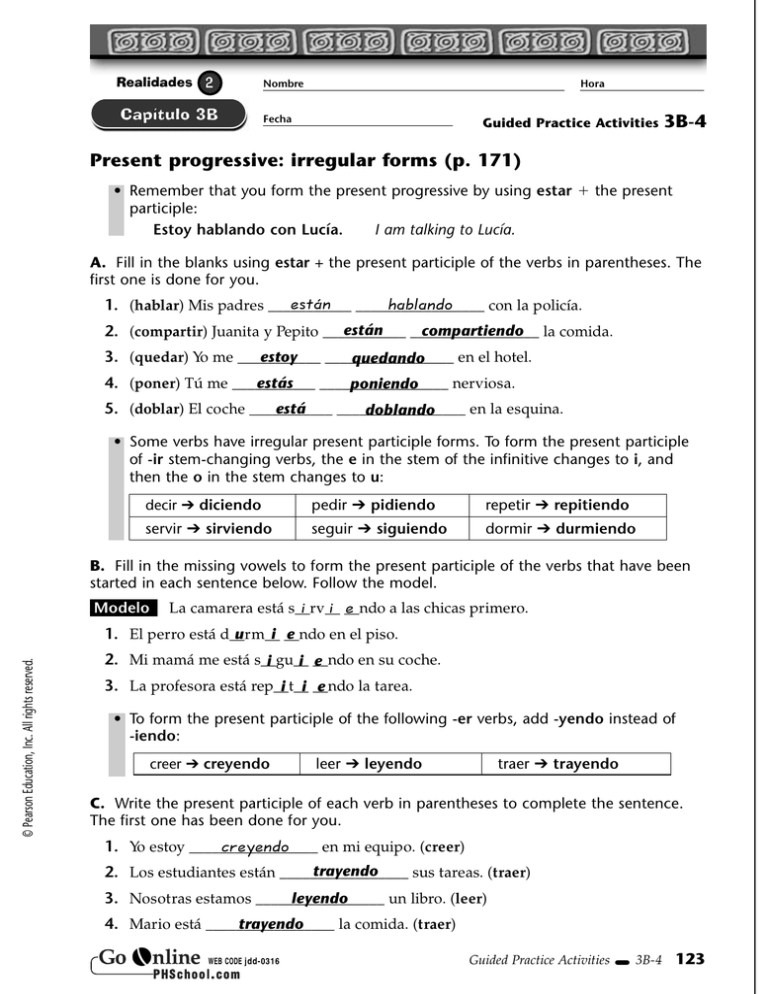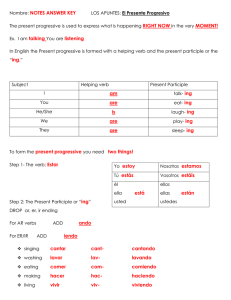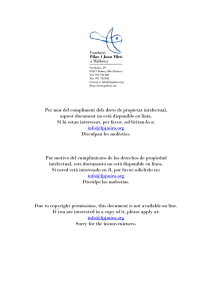Present progressive: irregular forms (p. 171) están hablando
Anuncio

Realidades Nombre Hora Fecha Guided Practice Activities 3B-4 Present progressive: irregular forms (p. 171) • Remember that you form the present progressive by using estar ⫹ the present participle: Estoy hablando con Lucía. I am talking to Lucía. A. Fill in the blanks using estar + the present participle of the verbs in parentheses. The first one is done for you. están _________________ hablando 1. (hablar) Mis padres ___________ con la policía. están compartiendo la comida. 2. (compartir) Juanita y Pepito ___________ _________________ 3. (quedar) Yo me ___________ _________________ en el hotel. estoy quedando 4. (poner) Tú me ___________ _________________ nerviosa. estás poniendo 5. (doblar) El coche ___________ _________________ en la esquina. está doblando • Some verbs have irregular present participle forms. To form the present participle of -ir stem-changing verbs, the e in the stem of the infinitive changes to i, and then the o in the stem changes to u: decir ➔ diciendo pedir ➔ pidiendo repetir ➔ repitiendo servir ➔ sirviendo seguir ➔ siguiendo dormir ➔ durmiendo B. Fill in the missing vowels to form the present participle of the verbs that have been started in each sentence below. Follow the model. Modelo i i __ndo e La camarera está s__rv__ a las chicas primero. © Pearson Education, Inc. All rights reserved. 1. El perro está d__rm__ en el piso. u i __ndo e 2. Mi mamá me está s__gu__ en su coche. i i __ndo e 3. La profesora está rep__t__ la tarea. i i __ndo e • To form the present participle of the following -er verbs, add -yendo instead of -iendo: creer ➔ creyendo leer ➔ leyendo traer ➔ trayendo C. Write the present participle of each verb in parentheses to complete the sentence. The first one has been done for you. creyendo 1. Yo estoy _________________ en mi equipo. (creer) trayendo 2. Los estudiantes están _________________ sus tareas. (traer) 3. Nosotras estamos _________________ un libro. (leer) leyendo 4. Mario está _________________ la comida. (traer) trayendo WEB CODE jdd- 0316 Guided Practice Activities 3B-4 123 Realidades Nombre Fecha Hora Guided Practice Activities 3B-4a Present progressive: irregular forms (continued ) D. Change the underlined verb in the following sentences from the present tense to the present progressive tense. Follow the model. Modelo Adriana dice la verdad. diciendo está ___________ _________________ 1. Tú pides ayuda. pidiendo estás ___________ _________________ 2. Mi padre lee el periódico. está leyendo ___________ _________________ 3. La profesora repite la pregunta. está repitiendo ___________ _________________ 4. Ana y yo traemos las bebidas. estamos _________________ trayendo ___________ 5. El camarero sirve la comida. está sirviendo ___________ _________________ 6. Paulo y Javier duermen en clase. están durmiendo ___________ _________________ 7. Los estudintes siguen al profesor. están siguiendo ___________ _________________ 8. Yo no te creo. estoy creyendo ___________ _________________ • When you use a direct object pronoun with a present progressive verb, the pronoun can either come before estar or attached to the present participle. It is necessary to add a written accent if the pronoun is attached to the present participle. Lara lo está trayendo. or Lara está trayéndolo. Modelo Felipe nos está llevando. ___________________________________________. Felipe está llevándonos 1. Nosotros lo estamos esperando. ___________________________________________. Nosotros estamos esperándolos 2. Ella me está siguiendo. ___________________________________________. Ella está siguiéndome 3. Tú las estás leyendo. ___________________________________________. Tú estás leyéndolas 4. Sancho me está diciendo la verdad. ___________________________________________. Sancho está deciéndome la verdad 5. El profesor nos está enseñando. 124 Guided Practice Activities 3B-4a ___________________________________________. El profesor está enseñándonos WEB CODE jdd- 0316 © Pearson Education, Inc. All rights reserved. E. Rewrite the sentences adding the direct object pronoun to the end of the present progressive form. Remember to write an accent on the stressed a or e. Follow the model.


